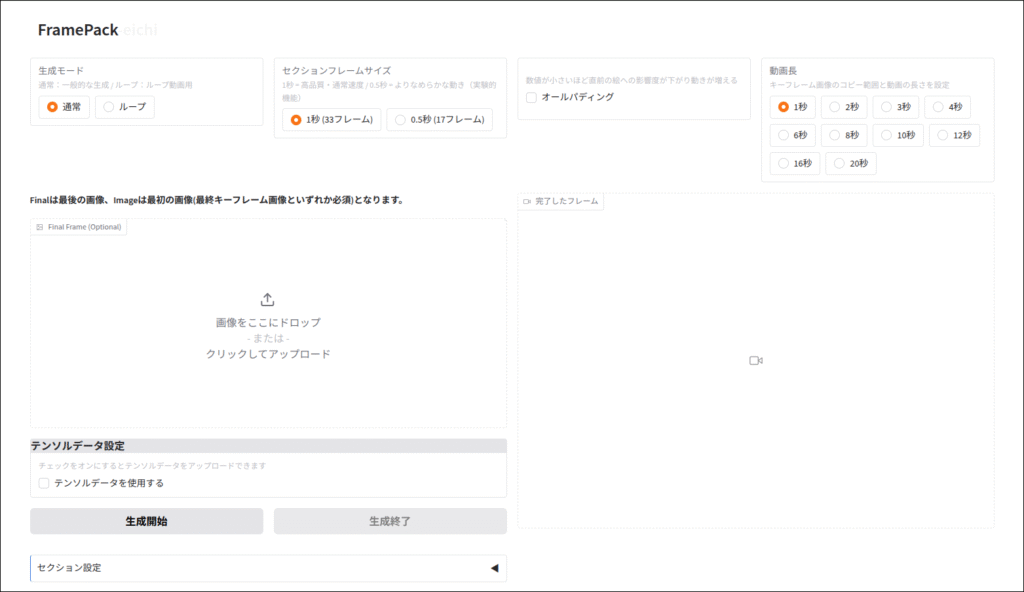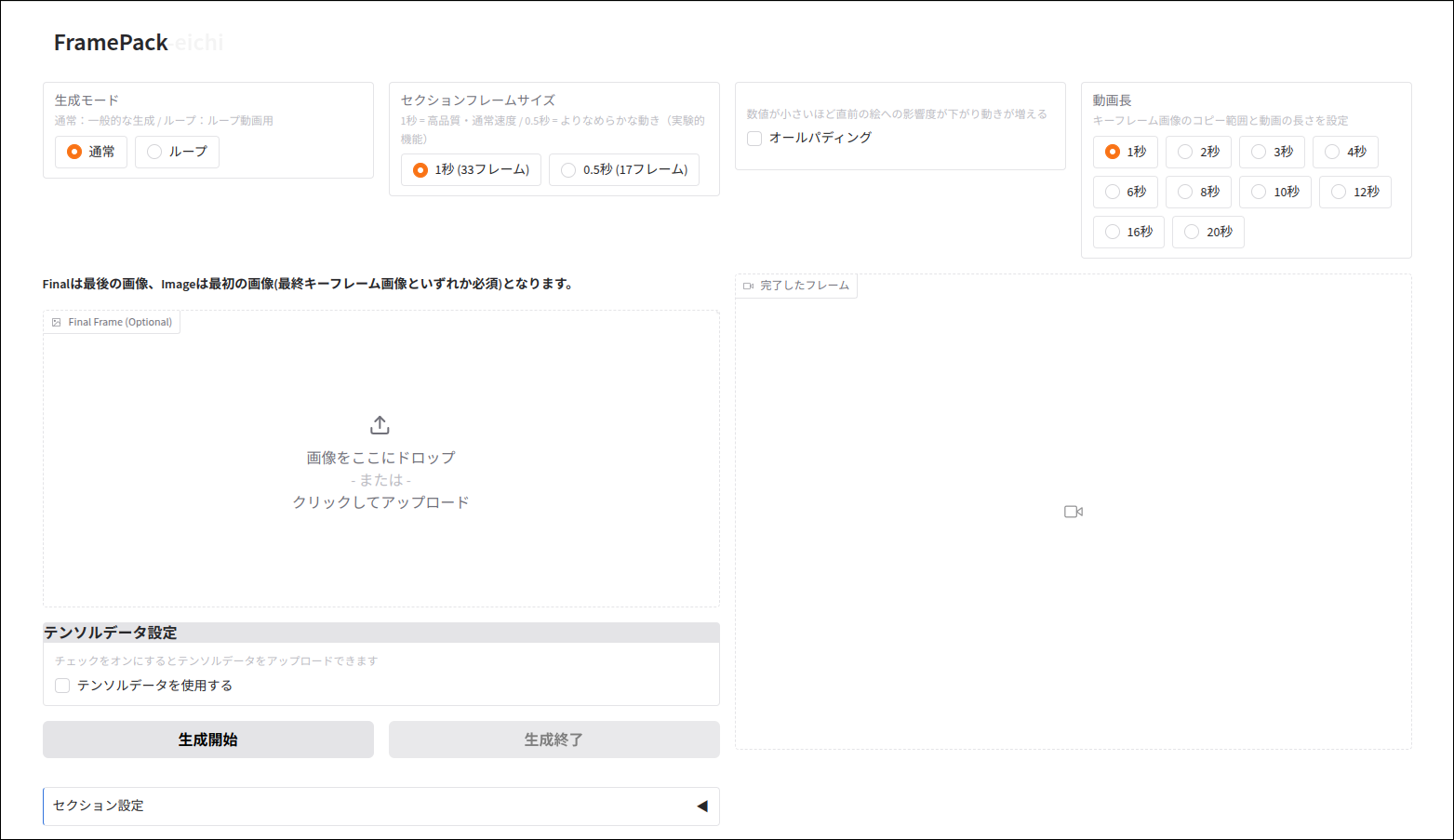本家FramePackではなくフォーク版のFramePack-eichiをIntel ARCで動かします。
なぜ本家でないのかというと、本家の方はlatentの生成まではできるのですが、VAEエンコードでクラッシュする問題が解決できないからです。
こちらのeichiの方はなぜかクラッシュすることもなく動作します。
ちなみに今回もUbuntu編ですが、たぶんWindowsでも動くのではないかと思います。
インストール手順
- memory.pyの書き換え
- 本家FramePackのダウンロード
- 本家FramePackの動作環境構築
- 本家FramePackを起動して「diffusers_helper」と「hf_download」をダウンロード
- FramePack-eichiをダウンロード
- 本家FramePackでダウンロードした「diffusers_helper」と「hf_download」と「requirements.txt」をFramePack-eichi/webuiに配置
- FramePack-eichiの動作環境構築
- FramePack-eichiの起動
で終わりです。
今回はインストールスクリプトで自動化できるところは自動化しようと思います。
memory.pyの書き換え
書き換えというか作成ですね。
# By lllyasviel (XPU対応版)
import torch
cpu = torch.device('cpu')
gpu = torch.device(f"xpu:{torch.xpu.current_device()}")
gpu_complete_modules = []
class DynamicSwapInstaller:
@staticmethod
def _install_module(module: torch.nn.Module, **kwargs):
original_class = module.__class__
module.__dict__['forge_backup_original_class'] = original_class
def hacked_get_attr(self, name: str):
if '_parameters' in self.__dict__:
_parameters = self.__dict__['_parameters']
if name in _parameters:
p = _parameters[name]
if p is None:
return None
if isinstance(p, torch.nn.Parameter):
return torch.nn.Parameter(p.to(**kwargs), requires_grad=p.requires_grad)
else:
return p.to(**kwargs)
if '_buffers' in self.__dict__:
_buffers = self.__dict__['_buffers']
if name in _buffers:
return _buffers[name].to(**kwargs)
return super(original_class, self).__getattr__(name)
module.__class__ = type('DynamicSwap_' + original_class.__name__, (original_class,), {
'__getattr__': hacked_get_attr,
})
return
@staticmethod
def _uninstall_module(module: torch.nn.Module):
if 'forge_backup_original_class' in module.__dict__:
module.__class__ = module.__dict__.pop('forge_backup_original_class')
return
@staticmethod
def install_model(model: torch.nn.Module, **kwargs):
for m in model.modules():
DynamicSwapInstaller._install_module(m, **kwargs)
return
@staticmethod
def uninstall_model(model: torch.nn.Module):
for m in model.modules():
DynamicSwapInstaller._uninstall_module(m)
return
def fake_diffusers_current_device(model: torch.nn.Module, target_device: torch.device):
if hasattr(model, 'scale_shift_table'):
model.scale_shift_table.data = model.scale_shift_table.data.to(target_device)
return
for _, p in model.named_modules():
if hasattr(p, 'weight'):
p.to(target_device)
return
def get_cuda_free_memory_gb(device=None):
if device is None:
device = gpu
if device.type == "xpu":
try:
props = torch.xpu.get_device_properties(device)
total_memory = props.total_memory
allocated = torch.xpu.memory_allocated(device)
free = total_memory - allocated
return free / (1024 ** 3)
except Exception as e:
print("[Warning] Failed to get XPU memory info:", e)
return 0
# fallback for CUDA (if you run on CUDA system)
if device.type == "cuda":
try:
memory_stats = torch.cuda.memory_stats(device)
bytes_active = memory_stats.get('active_bytes.all.current', 0)
bytes_reserved = memory_stats.get('reserved_bytes.all.current', 0)
bytes_free_cuda, _ = torch.cuda.mem_get_info(device)
bytes_inactive_reserved = bytes_reserved - bytes_active
bytes_total_available = bytes_free_cuda + bytes_inactive_reserved
return bytes_total_available / (1024 ** 3)
except Exception as e:
print("[Warning] Failed to get CUDA memory info:", e)
return 0
return 0
def move_model_to_device_with_memory_preservation(model, target_device, preserved_memory_gb=0):
print(f'Moving {model.__class__.__name__} to {target_device} with preserved memory: {preserved_memory_gb} GB')
for m in model.modules():
if get_cuda_free_memory_gb(target_device) <= preserved_memory_gb:
return
if hasattr(m, 'weight'):
m.to(device=target_device)
model.to(device=target_device)
return
def offload_model_from_device_for_memory_preservation(model, target_device, preserved_memory_gb=0):
print(f'Offloading {model.__class__.__name__} from {target_device} to preserve memory: {preserved_memory_gb} GB')
for m in model.modules():
if get_cuda_free_memory_gb(target_device) >= preserved_memory_gb:
return
if hasattr(m, 'weight'):
m.to(device=cpu)
model.to(device=cpu)
return
def unload_complete_models(*args):
for m in gpu_complete_modules + list(args):
m.to(device=cpu)
print(f'Unloaded {m.__class__.__name__} as complete.')
gpu_complete_modules.clear()
return
def load_model_as_complete(model, target_device, unload=True):
if unload:
unload_complete_models()
model.to(device=target_device)
print(f'Loaded {model.__class__.__name__} to {target_device} as complete.')
gpu_complete_modules.append(model)
return
このスクリプトをテキストファイルに書き込んで「memory.py」というファイル名にしてください。

本家FramePackを起動して「diffusers_helper」と「hf_download」「requirements.txt」をダウンロード
- 本家FramePackのダウンロード
- 本家FramePackの動作環境構築
- 本家FramePackを起動して「diffusers_helper」と「hf_download」と「requirements.txt」をダウンロード
をスクリプトで自動化します。
#!/bin/bash
cd ~
cd ./install
sudo apt update
sudo apt install -y git unzip python3 python3-pip python3-venv
sudo apt install -y libgoogle-perftools-dev
git clone https://github.com/lllyasviel/FramePack.git
mv ./memory.py ./FramePack/diffusers_helper/
cd ./FramePack
python3 -m venv venv
source ./venv/bin/activate
python -m pip install torch==2.7.0 torchvision==0.22.0 torchaudio==2.7.0 --index-url https://download.pytorch.org/whl/xpu
python -m pip install intel-extension-for-pytorch==2.7.10+xpu oneccl_bind_pt==2.7.0+xpu --extra-index-url https://pytorch-extension.intel.com/release-whl/stable/xpu/us/
pip install -r ./requirements.txt
python ./demo_gradio.py適当にテキストファイルに書き込んでファイル名「install.sh」とかにして「bash ./install.sh」で実行すれば、本家FramePackのインストールとファイルのダウンロードが始まると思います。
一応自分の環境でも動作することは確認していますが、もし上手く行かない場合は手動でお願いします。
ファイルのダウンロードはかなり時間がかかると思いますが(特に「hf_download」が40GBくらいある)、ぐっとこらえましょう。
ダウンロードが終わったら、本家FramePackは終了してください。
FramePack-eichiの起動
- FramePack-eichiをダウンロード
- 本家FramePackでダウンロードした「diffusers_helper」と「hf_download」と「requirements.txt」をFramePack-eichi/webuiに配置
- FramePack-eichiの動作環境構築
- FramePack-eichiの起動
この流れをスクリプトで自動化します。
#!/bin/bash
cd ~
cd ./install
git clone https://github.com/git-ai-code/FramePack-eichi.git
mv ./FramePack/diffusers_helper ./FramePack/hf_download ./FramePack/requirements.txt ./FramePack-eichi/webui/
cd ./FramePack-eichi/webui
python3 -m venv venv
source ./venv/bin/activate
python -m pip install torch==2.7.0 torchvision==0.22.0 torchaudio==2.7.0 --index-url https://download.pytorch.org/whl/xpu
python -m pip install intel-extension-for-pytorch==2.7.10+xpu oneccl_bind_pt==2.7.0+xpu --extra-index-url https://pytorch-extension.intel.com/release-whl/stable/xpu/us/
pip install -r ./requirements.txt
python ./endframe_ichi.py --inbrowser先程使った「install.sh」に上書きして「bash ./install.sh」で実行します。

使い方はyoutubeとかみれば情報はたくさんあると思います。
ちなみに今回から、Intel Extension for PyTorch「v2.7.10 + xpu」を使用しています。
これはIntel ARC AシリーズとBシリーズの両方に対応していますので、インストール方法は同じはずです(Aシリーズ持ってないから試せない・・・)。
今回使ったB580です。
Challenger安くなってますね。
今回は以上です。


コメント